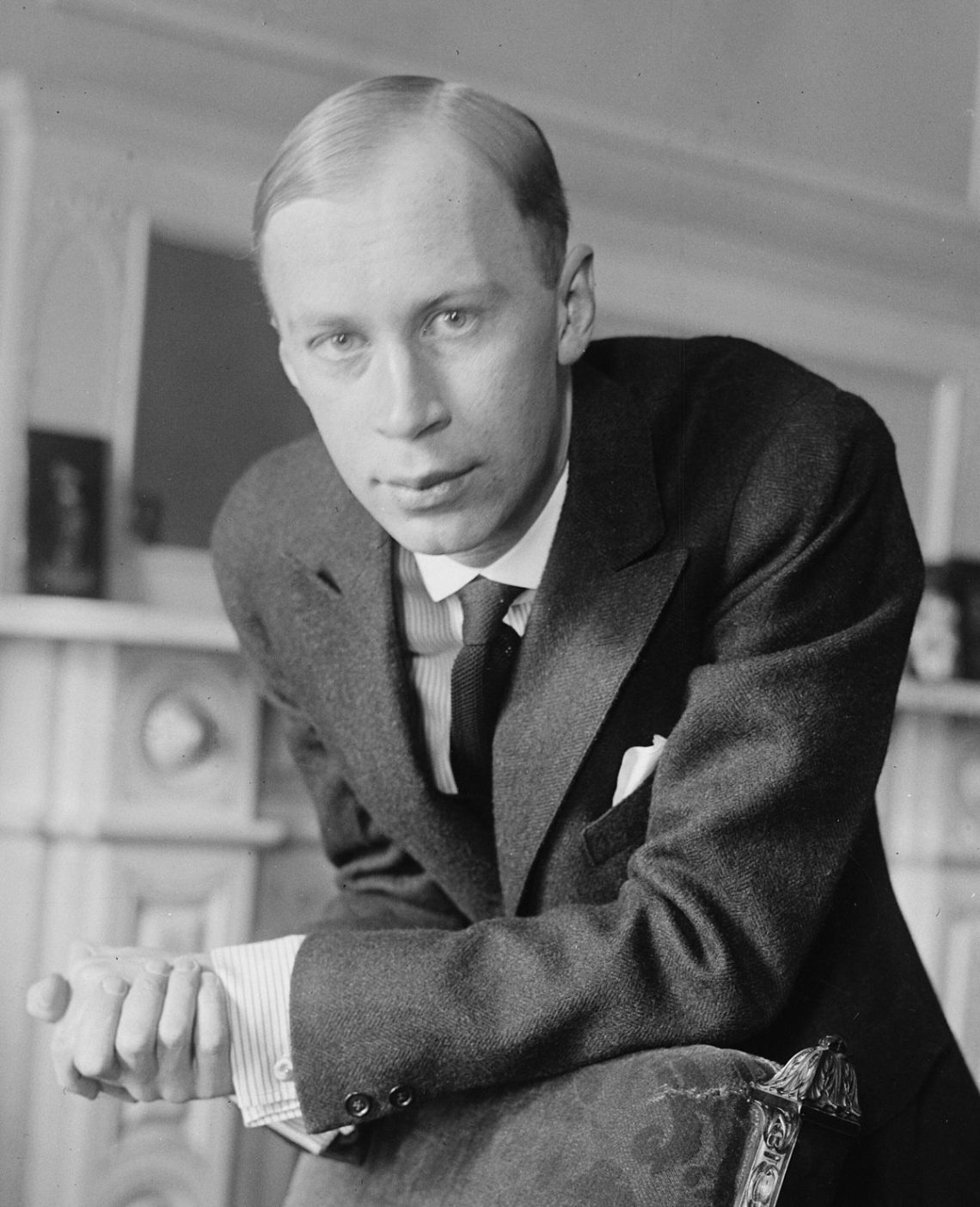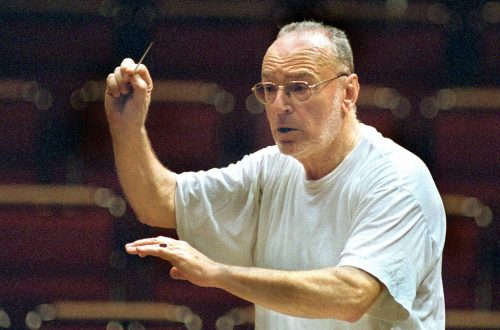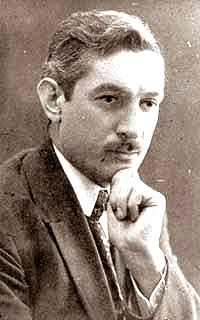
Sergei Sergeevich Prokofiev |
Sergei Prokofiev
The cardinal advantage (or, if you like, disadvantage) of my life has always been the search for an original, my own musical language. I hate imitation, I hate cliches…
You can be as long as you like abroad, but you must certainly return to your homeland from time to time for the real Russian spirit. S. Prokofiev
The childhood years of the future composer passed in a musical family. His mother was a good pianist, and the boy, falling asleep, often heard the sounds of L. Beethoven’s sonatas coming from afar, several rooms away. When Seryozha was 5 years old, he composed his first piece for piano. In 1902, S. Taneyev became acquainted with his children’s composing experiences, and on his advice, composition lessons began with R. Gliere. In 1904-14 Prokofiev studied at the St. Petersburg Conservatory with N. Rimsky-Korsakov (instrumentation), J. Vitols (musical form), A. Lyadov (composition), A. Esipova (piano).
At the final exam, Prokofiev brilliantly performed his First Concerto, for which he was awarded the Prize. A. Rubinstein. The young composer eagerly absorbs new trends in music and soon finds his own path as an innovative musician. Speaking as a pianist, Prokofiev often included his own works in his programs, which caused a strong reaction from the audience.
In 1918, Prokofiev left for the USA, starting further on a series of trips to foreign countries – France, Germany, England, Italy, Spain. In an effort to win over the world audience, he gives concerts a lot, writes major works – the operas The Love for Three Oranges (1919), The Fiery Angel (1927); the ballets Steel Leap (1925, inspired by the revolutionary events in Russia), The Prodigal Son (1928), On the Dnieper (1930); instrumental music.
At the beginning of 1927 and at the end of 1929, Prokofiev performed with great success in the Soviet Union. In 1927, his concerts are held in Moscow, Leningrad, Kharkov, Kyiv and Odessa. “The reception that Moscow gave me was out of the ordinary. … The reception in Leningrad turned out to be even hotter than in Moscow, ”the composer wrote in his Autobiography. At the end of 1932, Prokofiev decides to return to his homeland.
Since the mid 30s. Prokofiev’s creativity reaches its heights. He creates one of his masterpieces – the ballet “Romeo and Juliet” after W. Shakespeare (1936); the lyric-comic opera Betrothal in a Monastery (The Duenna, after R. Sheridan – 1940); cantatas “Alexander Nevsky” (1939) and “Toast” (1939); a symphonic fairy tale to his own text “Peter and the Wolf” with instruments-characters (1936); Sixth Piano Sonata (1940); cycle of piano pieces “Children’s Music” (1935).
In the 30-40s. Prokofiev’s music is performed by the best Soviet musicians: N. Golovanov, E. Gilels, B. Sofronitsky, S. Richter, D. Oistrakh. The highest achievement of Soviet choreography was the image of Juliet, created by G. Ulanova. In the summer of 1941, at a dacha near Moscow, Prokofiev was painting commissioned by the Leningrad Opera and Ballet Theatre. S. M. Kirov ballet-tale “Cinderella”. The news of the outbreak of war with fascist Germany and the subsequent tragic events caused a new creative upsurge in the composer. He creates a grandiose heroic-patriotic epic opera “War and Peace” based on the novel by L. Tolstoy (1943), and works with director S. Eisenstein on the historical film “Ivan the Terrible” (1942). Disturbing images, reflections of military events and, at the same time, indomitable will and energy are characteristic of the music of the Seventh Piano Sonata (1942). Majestic confidence is captured in the Fifth Symphony (1944), in which the composer, in his words, wanted to “sing of a free and happy man, his mighty strength, his nobility, his spiritual purity.”
In the post-war period, despite a serious illness, Prokofiev created many significant works: the Sixth (1947) and Seventh (1952) symphonies, the Ninth Piano Sonata (1947), a new edition of the opera War and Peace (1952), the Cello Sonata (1949) and the Symphony Concerto for cello and orchestra (1952). Late 40s-early 50s. were overshadowed by noisy campaigns against the “anti-national formalist” direction in Soviet art, the persecution of many of its best representatives. Prokofiev turned out to be one of the main formalists in music. The public defamation of his music in 1948 further worsened the composer’s health.
Prokofiev spent the last years of his life at a dacha in the village of Nikolina Gora among the Russian nature he loved, he continued to compose continuously, violating the prohibitions of doctors. The difficult circumstances of life also affected creativity. Along with genuine masterpieces, among the works of recent years there are works of a “simplistic conception” – the overture “Meeting of the Volga with the Don” (1951), the oratorio “On Guard of the World” (1950), the suite “Winter Bonfire” (1950), some pages of the ballet “Tale about a stone flower” (1950), Seventh Symphony. Prokofiev died on the same day as Stalin, and the farewell to the great Russian composer on his last journey was obscured by popular excitement in connection with the funeral of the great leader of the peoples.
Prokofiev’s style, whose work covers 4 and a half decades of the turbulent XNUMXth century, has undergone a very great evolution. Prokofiev paved the way for the new music of our century, together with other innovators of the beginning of the century – C. Debussy. B. Bartok, A. Scriabin, I. Stravinsky, composers of the Novovensk school. He entered art as a daring subverter of the dilapidated canons of late Romantic art with its exquisite sophistication. In a peculiar way developing the traditions of M. Mussorgsky, A. Borodin, Prokofiev brought into music unbridled energy, onslaught, dynamism, freshness of primordial forces, perceived as “barbarism” (“Obsession” and Toccata for piano, “Sarcasms”; symphonic “Scythian Suite” according to ballet “Ala and Lolly”; First and Second Piano Concertos). Prokofiev’s music echoes the innovations of other Russian musicians, poets, painters, theater workers. “Sergey Sergeevich plays on the most tender nerves of Vladimir Vladimirovich,” V. Mayakovsky said about one of Prokofiev’s performances. Biting and juicy Russian-village figurativeness through the prism of exquisite aesthetics is characteristic of the ballet “The Tale of the Jester Who Cheated on Seven Jesters” (based on fairy tales from A. Afanasyev’s collection). Comparatively rare at that time lyricism; in Prokofiev, he is devoid of sensuality and sensitivity – he is shy, gentle, delicate (“Fleeting”, “Tales of an Old Grandmother” for piano).
Brightness, variegation, increased expression are typical of the style of foreign fifteen years. This is the opera “Love for Three Oranges”, splashing with joy, with enthusiasm, based on the fairy tale by K. Gozzi (“a glass of champagne”, according to A. Lunacharsky); the splendid Third Concerto with its vigorous motor pressure, set off by the wonderful pipe melody of the beginning of the 1st part, the penetrating lyricism of one of the variations of the 2nd part (1917-21); the tension of strong emotions in “The Fiery Angel” (based on the novel by V. Bryusov); the heroic power and scope of the Second Symphony (1924); “Cubist” urbanism of “Steel lope”; lyrical introspection of “Thoughts” (1934) and “Things in themselves” (1928) for piano. Style period 30-40s. marked by the wise self-restraint inherent in maturity, combined with the depth and national soil of artistic concepts. The composer strives for universal human ideas and themes, generalizing images of history, bright, realistic-concrete musical characters. This line of creativity was especially deepened in the 40s. in connection with the ordeals that befell the Soviet people during the war years. Disclosure of the values of the human spirit, deep artistic generalizations become the main aspiration of Prokofiev: “I am of the conviction that the composer, like the poet, sculptor, painter, is called to serve man and the people. It should sing of human life and lead a person to a brighter future. Such, from my point of view, is the unshakable code of art.
Prokofiev left a huge creative heritage – 8 operas; 7 ballets; 7 symphonies; 9 piano sonatas; 5 piano concertos (of which the Fourth is for one left hand); 2 violin, 2 cello concertos (Second – Symphony-concert); 6 cantatas; oratorio; 2 vocal and symphonic suites; many piano pieces; pieces for orchestra (including Russian Overture, Symphonic Song, Ode to the End of the War, 2 Pushkin Waltzes); chamber works (Overture on Jewish themes for clarinet, piano and string quartet; Quintet for oboe, clarinet, violin, viola and double bass; 2 string quartets; 2 sonatas for violin and piano; Sonata for cello and piano; a number of vocal compositions for words A. Akhmatova, K. Balmont, A. Pushkin, N. Agnivtsev and others).
Creativity Prokofiev received worldwide recognition. The enduring value of his music lies in his generosity and kindness, in his commitment to lofty humanistic ideas, in the richness of the artistic expression of his works.
Y. Kholopov
- Opera works by Prokofiev →
- Piano works by Prokofiev →
- Piano Sonatas by Prokofiev →
- Prokofiev the pianist →





